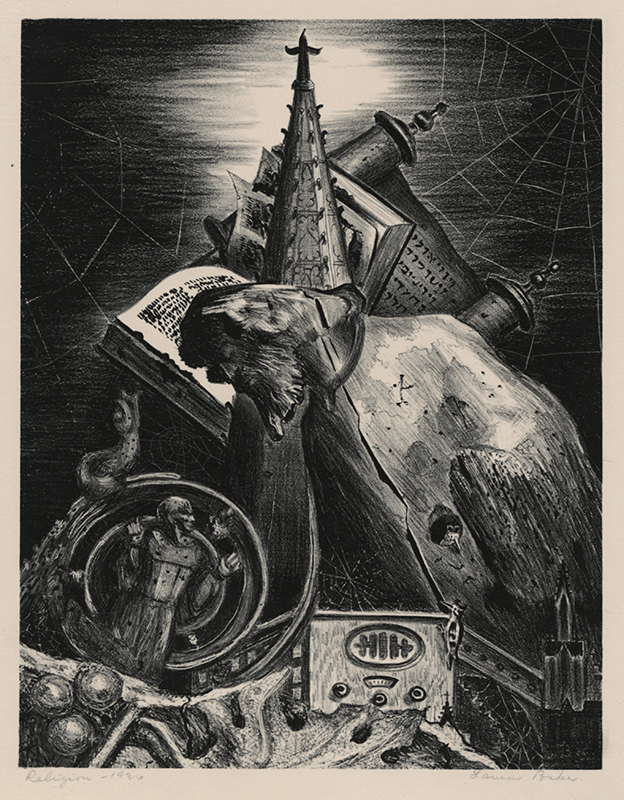
19th, 20th & 21st Century Fine Prints
707-546-7352 · fax 707-546-7924 · web: www.annexgalleries.com · email: artannex@aol.com
Religion by Lamar G. Baker

Religion
Lamar G. Baker
Religion
Lamar G. Baker
1908 - 1994 (biography)Baker depicts symbols of religions, gathering dust and spiderwebs, as though seen through the lens of time. A carved prophet is split through the middle by a tiny woodpecker, who is perched on the edge of a radio, symbolizing perhaps the destructive nature of commercialized Evangelicalism. Scrolls and tomes are bedecked in spiderwebs and wormholes riddle the wooden architectural details of medieval churches.
Baker did not shrink from exploring difficult and often controversial ideas, using art as a platform to critique the hypocrisy of social norms and prejudices. While his work often falls into the Surrealist catgory, it was often less veiled, and more pointed, than many of his contemporaries.
Lamar Baker was born in 1908 in Atlanta, Georgia. He studied at Columbus' High Institute of Art and at the University of Georgia under Ben Shute, and at the Castle Studio, also in Georgia. In 1935 he moved to New York to attend the Art Students League, where he studied printmaking under Kenneth Hayes Miller, Rico Le Brun, and Harry Sternberg. Sternberg's social realist style was of great influence to Baker, as was the work of Thomas Hart Benton, Louis Lozowick, and John McCrady. During this time he created several lithographic series dealing with a range of sociopolitical issues, his most well-known of which was the Cotton Series, which examined not only with the inherent racism of the industry, but the back-door politics and anti-union sentiments that affected black, white, male and female workers alike.
In 1942, Baker won a Julius Rosenwald Fund fellowship that enabled him to travel through Mississippi and Louisiana. En route he was inspired to create a series of five paintings around the theme of African American spiritual songs, which remain among his most recognized work and is housed in the Columbus Museum in Georgia. He worked for RKO Pictures in New York as a commercial artist until 1951, when he returned to Georgia, settling near Columbus with his new wife, where he would teach art classes and work for the Litho-Krome Company until 1977.
Baker was considered a Regionalist, his work focusing on the people and places where he grew up, even as he worked and lived in other states. With his love of his homeland came a critique that remained a major tenet of his oeuvre. According to the Columbus Museum, to whom Baker bequeathed around half of his work at the end of his career, Baker stands out in the history of modern American art in that he was a white male who "frequently focused his work on the social issues of racial injustice and violence during the 1940s. Leading graphic arts historian and curator Carl Zigrosser described him as 'one of the first native artists to reckon with the problems of the new South.' His later work often investigated issues of mortality."
